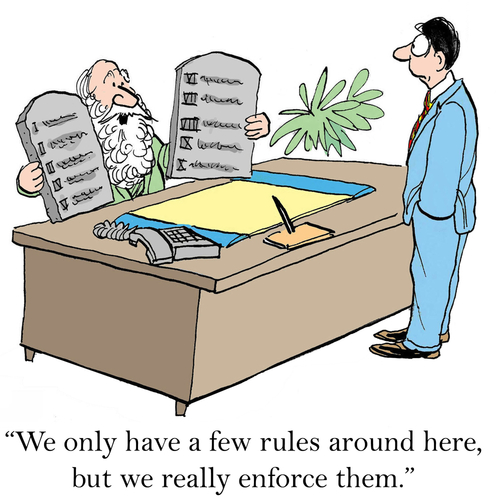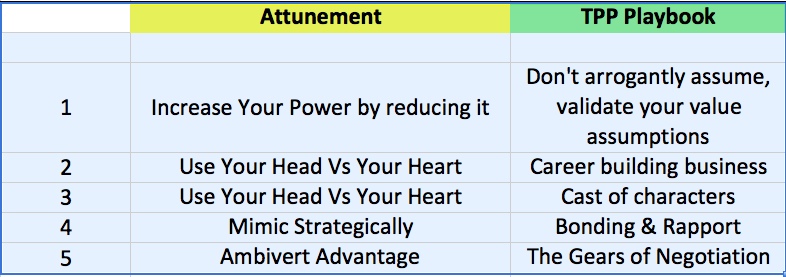When I devoured Daniel Pink’s new book, To Sell is Human, in February on vacation in Puerto Rico I tweeted that I was buying it for all my clients! Firstly because it was a great book, secondly it articulated the new rules of sales and finally it supported my playbook. My playbook was influenced by three main factors: first, closing $50m M&A deals in London for 15 years, second the work of Jeff Thull and the Prime Process and finally the tactical genius of the Sandler System. Over the last 7 years I’ve tweaked the playbook successfully to scale businesses in software, services and manufacturing. It turns out the latest research on “How we move people” and how we sell successfully supports what I’ve been doing. So over the next few blog posts I’m going to reconcile the thinking and research behind Daniel’s new book and the practical sales process I use.
This first blog post focuses on Attunement part of the new ABC. Instead of the traditional ABC of selling – Always Be Closing, Daniel asserts the new world of selling is about Attunement, Buoyancy and Clarity.
First let me reconcile in a short table Daniel Pink’s thesis on attunement and TPP’s playbook:
- Power Base: The research proves that if you take a set of individuals who have a strong sense of power then their ability to see the other sides’ perspective is weak. Participants in the research with low power attributes performed much better in their ability to perceive the other side’s position.
Execution Tip: Our playbook emphasizes the need to validate your early assumptions surrounding prospects. The discovery phase of our playbook demands that sales professionals prepare logical assumptions regarding the prospects issues and needs. But then comes insightful initial conversations to validate those needs with smart questions to really clarify a position. That’s perspective thinking and is a cornerstone of attunement. So turn down the power trip and learn more but don’t over do it. You are in the conversation on equal terms. - Head Vs. Heart: The skill of attunement requires perspective thinking. That’s the ability to see the other person’s worldview. The skill of really understanding someone’s stance. It also requires empathy, the ability to connect emotionally with your prospect, or class or partner, or daughter or whoever you are trying to move. But here is where research is powerful. It turns out that perspective thinking trumps the empathy piece. The head is stronger than the heart.
Execution Tip #1: As you engage with a prospect we teach a key mindset – think of yourself as being in the “career building” business. In other words the key to the conversation is to understand your prospect’s monthly and quarterly personal objectives. You are not selling to IBM, you are selling to Frank! Only by understanding the issues and the consequences that affect Frank can you hope to understand the priority problem worth solving.
Execution Tip #2: We find it essential to really map the prospect/customer company. You need to understand the players on the stage, the cast of characters. Subtlety is important here. Do you really understand the decision making process? Do you really understand the authorization process? What is the capability of your prospect/sponsor. Does she have the skills to manage the sales process inside her company? You need to understand the political landscape, the priorities of the key players and the interplay between them. - Mimic Strategically: We are all born mimickers. Well we think we are. The problem with bad mimicking is that it backfires! However the research again is quite compelling. It seems that people subconsciously trust people that are gently mimicking them. The book cites a Dutch study on waitresses who repeated diners’ orders with the outcome of achieving 70% more tips. Or retail salespersons in a study that delivered sales 79% of the time when mimicking was deployed compared with 62% when it was not deployed.
Execution Tip: Based on our own experience in the high pressure world of closing M&A deals and large commercial contracts, we would totally endorse mimicking. Bonding and rapport is the Sandler phrase used. Specifically think about the pace and tone of voice from the other side. Try to match that style without copying it. In face to face negotiations watch for the prospect that leans forward or moves their hands to make gestures. A prospect that is laconic does not want to hear a verbose explanation. I see the simplest mistakes spoiling the bonding and rapport moments, namely not acknowledging a key statement made by the other side. Why? Because you are thinking about what you want to say! Be human. It’s ok to struggle. It’s ok to say I’m sorry could you help me understand that point. - Ambivert Advantage: The extravert is clearly in the best position to succeed in sales. The outgoing, polished, confident, sociable, smooth personality was built for sales. Right? One small problem with that assertion. The research just doesn’t support it. In fact going the other way and filling your sales team with introverts isn’t ideal either. No the research clearly points to the middle ground – the ambivert. A personality that is quietly confident but always listening, always trying to work out the best way forward.
Try Daniel’s test here.
Execution Tip: We learned over the years that a negotiator needs to learn to move fast, slow and somewhere in between. We think of it as gears in a car. If you start a conversation in a sales negotiation context in sixth gear you have nowhere to go. Extraverts tend to be in fifth or sixth gear all day. It’s how they roll! Better to be in first or second gear with the capacity to move up to sixth and down to third in a heart beat. This takes a lot of practice. The ambivert personality is therefore ideally suited for negotiation. The introvert is in danger of staying in first gear.









